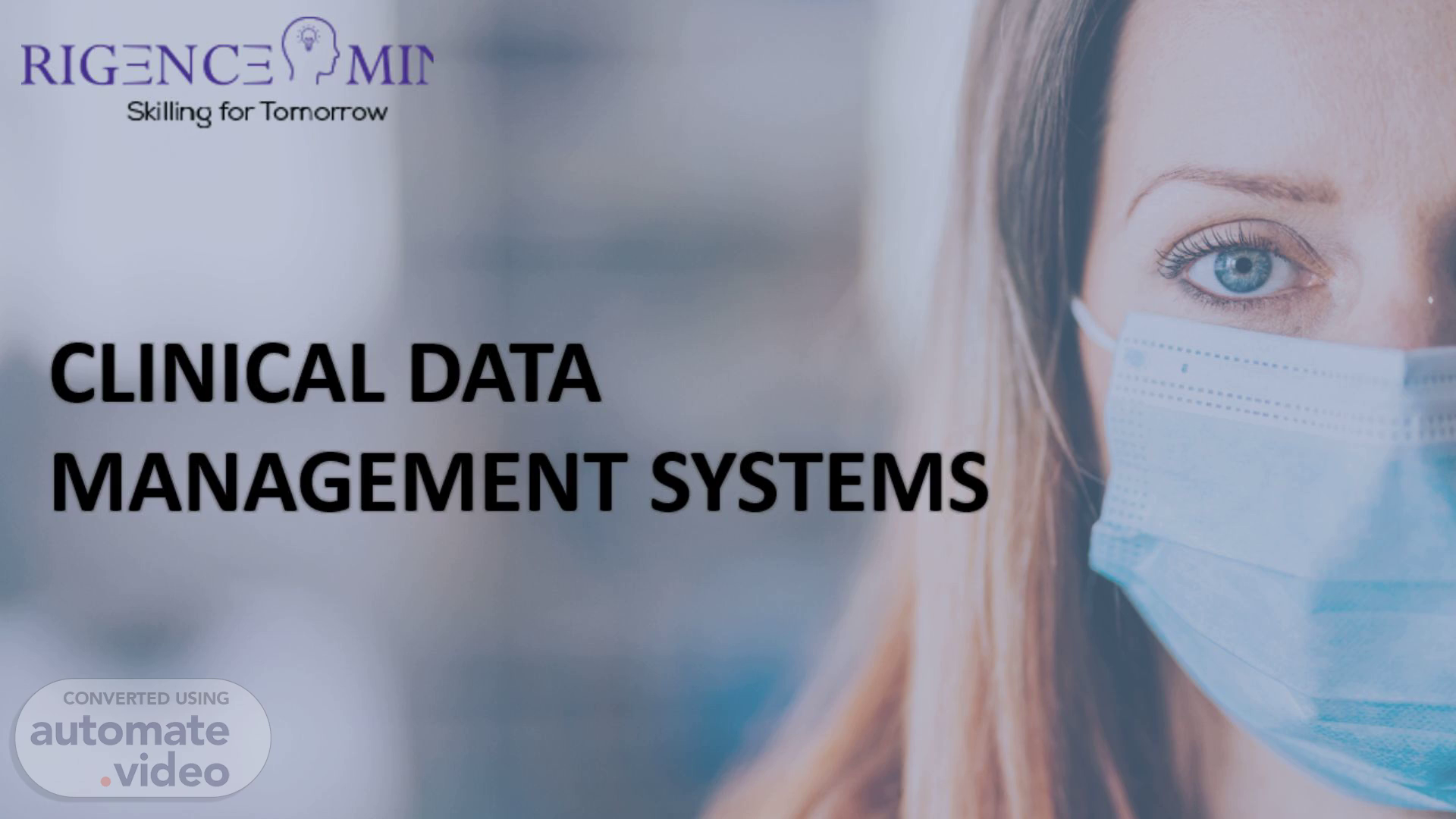
Clinical Data Management Systems
Scene 1 (0s)
Clinical Data Management Systems.
Scene 2 (6s)
Objectives. To become familiar with the types of CDMS used in the Pharma industry To understand the types of advancements made in CDMS To understand the unique features of an Electronic Data Capture (EDC) System.
Scene 3 (19s)
Methods of Data Collection. Paper Data transcribed onto paper CRF and entered by Sponsor into the database Can be uploaded from reports or datasets (e.g.: labs) Electronic Instruments (ECG, lab instruments)- data is transferred and loaded Electronic Data Capture (EDC) systems – investigational staff enters data initially into database or data is captured directly into database from instrumentation Remote Data Entry (RDE) – data is entered at the investigational site either directly of from source documents or paper copies of the CRFs.
Scene 4 (42s)
Types of Clinical Data Management Systems. Paper based Entry of CRF data by Sponsor Generation of query/data clarification form Examples: Oracle Corporation - Oracle Clinical™ Classical Phase Forward Corporation - Clintrial ™.
Scene 5 (55s)
Types of Clinical Data Management Systems. Electronic Data Capture Investigational site enters Online validation functionality Direct capture from instrumentation Examples: Oracle Clinical ™ Remote Data Capture Phase Forward InForm ™= Now acquired by Oracle Medidata- Rave.
Scene 6 (1m 6s)
Electronic Data Capture. Collecting or acquiring data as a permanent electronic record with or without human interface (e.g., using data collection systems or applications that are modem based, web based, optical mark/character recognition, or involve audio text, interactive voice response, graphical interfaces, or touch screens). CDISC NOTE: “permanent” in the context of these definitions implies that any changes made to the electronic data are recorded via an audit trail.
Scene 7 (1m 28s)
Electronic Data Capture. Hardware Types Desktop Handheld-Palm Pilot Notebook Tablet Ownership – Sponsor vs. Investigator Transfer of data Online vs. Offline entry Internet vs. Modem.
Scene 8 (1m 40s)
Enhancements to Paper-based Systems. Imaging and Workflow Systems CRF is faxed or scanned into system at investigator site or Sponsor/CRO May contain workflow features that allow: Automated data acquisition from image Access to CRF image by study team members Addition of electronic comments to CRF To accompany queries from investigators Correction of the CRF image when correction indicated by Data Clarification Form (DCF) Sending of Data Clarification Forms (DCFs) and imaging of completed DCFs Alignment of CRF and/or DCF image with corresponding Data Entry Screen.
Scene 9 (2m 4s)
Automated Data Acquisition from Optical Images. Optical Mark Recognition (OMR) Marks made in predetermined places on the CRF converted to electronic values Examples: yes/no checkboxes, barcodes Optical Character Recognition (OCR) Handwritten numbers/letters (usually restricted to boxes) are recognized Intelligent Character Recognition (ICR) Type of OCR which has the ability to guess at unrecognized symbols, retain a ‘memory’ of those previously encountered, and apply rules of association to enable interpretation.
Scene 10 (2m 25s)
Paper CRF Flow Example. MC900332580 MC900355021 MC900056674 CDM Performs Source Data Verification on a regular basis Send missing pages Checks and requests missing pages CRA Checks missing pages within Website Completes CRF pages (signs/dates if needed) Sends original pages using pre-printed envelops Keeps one copy for ISF Investigator.
Scene 11 (2m 41s)
Prints PDF file Resolves and signs/dates queries Sends in pre-printed envelops Keeps one copy for ISF.
Scene 12 (3m 0s)
Performs data validation Issues the discrepancies Tracks missing pages.
Scene 13 (3m 18s)
EDC Evolution….. First systems provided mechanism for investigational sites to enter their data (remote data entry) Many investigators completed paper copies of e-CRFs and entered these into database Expected benefits: 1. Earlier access to data by Sponsor 2. Quicker and easier cleaning of data as queries are generated close to the time of data generation 3. Reduction in monitoring and data management costs.
Scene 14 (3m 38s)
To gain acceptance….. EDC systems had to focus on benefits to the Investigational Site as well as to the Sponsor Reduce/ease workload of user Enter data directly into database (database equivalent to source documentation) Allow data from instruments to be directly transferred to database (e.g., vital signs monitors, ECG, etc.) Provide information to user Protocol, protocol amendments Status of study/enrollment of sites Direct correspondence with Sponsor And more….
Scene 15 (3m 59s)
EDC - Things to Consider. Need to assess appropriateness of EDC for the study Compliance with 21 CFR Part 11 Guidance Software systems validated User Acceptance Testing completed Database development and testing must be completed prior to study start Includes edit checks that will ‘fire’ upon entry to assure quality of single entry process Must not restrict responses of site * ‘Soft” edit checks (can be overridden) * Investigator comment fields.
Scene 16 (4m 19s)
EDC - Things to Consider. Assure functionality is present or linkages to other systems are in place (e.g., coding, loading of labs) Ensure access to system is limited to authorized individuals and site has access during the length of trial Ensure training is provided for all users Ensure availability of technical support (24/7) Roles of CRA Monitor and Data Manager will change - need to clearly define responsibilities and procedures (SOPs).